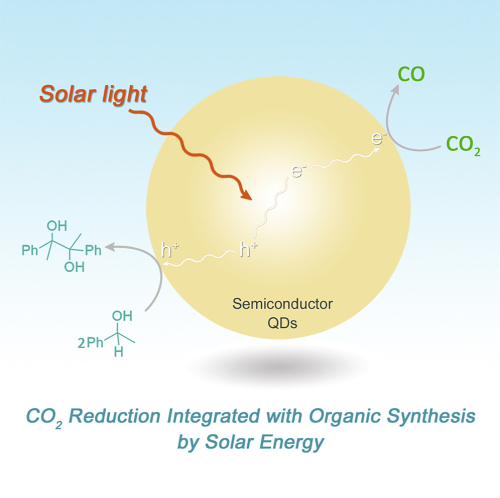Very recently, Chinese researchers developed a new system to integrate CO2 photoreduction with oxidative organic synthesis to simultaneously produce solar fuels and value-added chemicals.
This research, published online in Chem, was directed by Prof. WU Lizhu Wu and Dr. LI Xubing from Technical Institute of Physics and Chemistry (TIPC) of the Chinese Academy of Sciences.
In nature, green plants arguably take in CO2 and water to produce carbohydrate and oxygen (CO2 + H2O + hv → O2 + [CH2O]), thus converting solar energy into chemical fuels. Inspired by this process, tremendous efforts have been devoted to establishing efficient and cost-effective artificial photosystems for CO2 reduction during the past decades. However, traditional systems are suffering from either low activity/selectivity or the expense of sacrificial reagents.

Figure 1. Scheme of QDs photocatalyzed CO2 reduction and oxidative organic synthesis under solar light.
Here, we describe the first example of semiconductor quntum dots (QDs) catalysed CO2 reduction integrated with organic synthesis by solar energy. CO2-to-CO conversion can proceed with exciting activity and selectivity (>96%) when integrated with oxidative C-C coupling of 1-phenylethanol and derivatives to corresponding pinacols with excellent yields (>98%). The released protons and electrons of oxidative half-reaction are used for the reductive half-reaction of CO2 reduction.
Owing to its extremely high activity and cost-effective nature, this method shows great potential applications in solar-driven CO2 conversion on a large scale in the near future.
This work is supported by the Ministry of Science and Technology of China, the National Science Foundation of China, and the Strategic Priority Research Program of the Chinese Academy of Science.
https://www.cell.com/chem/fulltext/S2451-9294(19)30281-5
Email: lzwu@mail.ipc.ac.cn
NEWS